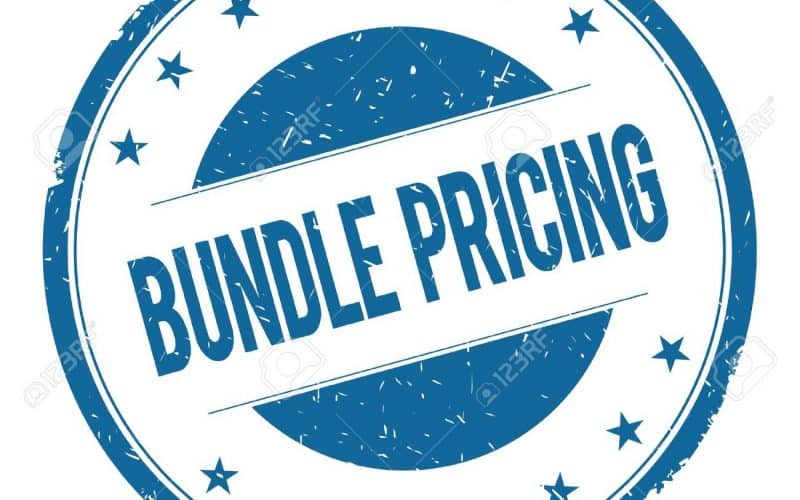When customers buy similar goods together, whether, in a fixed package or a choose-your-own kit, it’s easier for them to see the benefit those products provide. That is the beauty of a bundle pricing strategy. So, not only do consumers enjoy the advantages of a suite of goods for a single purchase price, but the business also seems to be more valuable.
In today’s article, we’ll go over what price bundling is and how it can benefit your company, as well as provide some examples of it in action.
What is Bundle Pricing?
Bundle pricing is a What is the benefit of bundle pricing? in which a company or distributor bundles several goods and sells them at a single price rather than charging different rates for each of them. This implies that a package is a commodity in and of itself because it has an ID, a price, attributes, and so on. It is important to note that this bundle price strategy works well for services as well as goods.
The bundle pricing example below sells for $99 and includes a camera, a case, batteries, a camera case and strap, a photo album, a self lens, colored filters, hanging frames, clips, and string to hang photos from. That’s a lot of product, particularly when you realize that the camera itself costs about $60.
Bundle pricing is an excellent way to transfer goods efficiently. It offloads less-profitable SKUs and provides more value to your loyal customers.
Bundling is very popular in e-commerce and retail, and you’ll often see product packages on low-cost or discounted products. However, it is not the only application for price bundling; businesses ranging from software to services (such as Comcast) use packages to market their goods.
Price is the most important “p” in the marketing mix, so bundling works. Price is frequently the most significant differentiator for customers. This is because when they can get a package price on goods they enjoy, they can feel as if they have found the best offer possible.
Bundle package pricing has benefits and drawbacks. On the one hand, it’s a fantastic strategy to use if you need to transfer merchandise quickly or provide great value to your customers. However, if done incorrectly, product bundling pricing will damage your brand. It is ultimately up to you to create a perfect plan that adds value while not tarnishing your reputation.
Types Of Bundle Pricing
#1. Pure Bundling
In this pricing strategy, certain things are paired and then sold together. The package comes as a bundle and customers buy the whole package in a bit to get one of it. It leads to more yield for the organization because they get to sell more of their product or services.
Leader bundling, joint bundling, and mixed-leader bundling are the three distinct subcategories of pure bundling.
#2. Mixed Pricing
A mixed bundle allows customers to decide on what they to buy. It is providing clients the choice to buy a bundle as well as the things individually, you’re doing mixed bundling or bespoke bundling. When you mix bundling, you can incentivize people to buy the bundle by selling it for a lower price than the sum of the individual items. Some consumers can get a discount on specific things, while others can pay full price if they don’t buy everything.
Examples of Bundle Pricing Strategy
Bundles, on the other hand, are particularly critical to Amazon’s strategy, and the online retailer makes extensive use of them (which you can learn about in our guide to selling on Amazon). There are several Amazon package examples, so it’s simple to dive in and see what works.
Example 1
On Amazon, there are two forms of bundling in general. The first is a Seller-created package. This kit is based on a single top performer — the Nikon camera — and includes 22 other “accessory” pieces such as camera belts, memory cards, lenses, tripods, flash cameras, and more. It’s the ideal package for someone who loves photography enough to invest in equipment but doesn’t already have everything a professional would need.
The secret to this package is that it is an excellent value for customers. It would take several hours to find all of these pieces separately. Also, it would almost certainly be more costly to buy each accessory separately. With this package, which costs $619, a customer will have their entire camera kit ready in two days. It’s the kind of package that will make an inexperienced photographer’s palms sweat and heart pound as they press “Add to Cart.”
The marketplace’s suggested product bundling strategy is the second form of product bundling strategy on Amazon. The picture below shows an Amazon page for a Magic Bullet blender, which retails for $38.
However, in the bottom left-hand corner of the picture, there is a segment on the page titled “Frequently purchased together”. That indicates two additional items to the customer. This is the Amazon-suggested pack, which uses Amazon’s algorithm to identify related items and recommend them in the same article. The shopper can easily add all three items to their cart with a single click. They know they’re getting everything they could need for this blender.
This recommended bundle pricing strategy is not limited to small electronics.
Example 2
Another perfect example of a bundled pricing approach comes from the British company Alpkit, which manufactures outdoor clothing. This bundle is based on the concept of a “mountain marathon,”. As the name suggests, a marathon takes place on mountain trails.
A bundle in the category of outdoor wear. This set comes with two jackets, gloves, socks, a tee, and waterproof running pants.
Since weather conditions can alter so rapidly in the wilderness, mountain marathons necessitate the use of specialized technical equipment. Many races require you to carry gloves, coats, and trousers with you while you run. But this professional gear is often prohibitively costly. Some runners can accumulate these pieces over time, but some of the individual pieces can be prohibitively expensive. For example, the rain jacket in the above kit, costs €120.
Alpkit addressed this issue with a smart package that includes most of the gear needed for a trial run. This package not only gets goods out of Alpkit’s warehouses, but it also saves the customer €98.
Bundle Pricing Strategy: How to Make and Use Them
To build successful price packages, you must first understand the consumer’s mindset. What exactly are they looking for, and how can you provide them with more value through a bundle
So, what can we take away from Alpkit and the other examples in this article about bundling? Here are a few examples:
- Recognize what the customers want, whether it’s a camera or mountain running gear.
- As a centerpiece, use a high-runner item.
- Easy accessories can be used to fill in the blanks.
Product popularity data (which you can obtain from Pricewatch) is an excellent resource for developing successful bundle packages. It allows you to determine which items are flying off the shelf and which are taking up inventory. If your slow-moving goods complement your fast-moving ones, you can combine the two to create a package that will help you clear out your warehouses. This is a particularly common strategy for electronics such as televisions and laptop computers. They often come in packages with charging cables, HDMI cords, and other accessories.
You can also build packages of famous items to make your top-runners even more appealing. If you notice that the most common goods in the market pair well together, you could build a “sale” package of these high-ticket items. Then you can sell it at a slightly higher price than you could if you discounted each product separately. You can still discount these items individually to push customers to your store with dynamic pricing.
Finally, packages can be used to give customers more leverage. If you use a “build your own package” model, you can allow customers to build their own packages from a pre-selected range of items. Then you can layer a discount percentage on top of their final selection.
Is Bundle Pricing Good?
When you sell related products or wish to boost the perceived value of low-volume items, bundle pricing works well.
What’s Bad about Bundle Pricing?
It can cannibalize your non-bundled products, which is its major drawback.
What Are the Advantages of Bundle Pricing?
Bundling can boost sales and profitability over time. Grouping things together enhances your average order value by encouraging clients to buy multiple items.
Bundle Pricing FAQs
How do you calculate bundle price?
When the bundle added to the opportunity, quote, order, or invoice includes optional products, the total price is calculated by adding the total price of the optional products to the price of the product bundle.
How do I bundle data in Excel
?Group by Using Shortcut Key
The shortcut key to quickly group the data is SHIFT + ALT + Right Arrow Key. First, select the rows that need to be grouped. Now press the shortcut key SHIFT + ALT + Right Arrow Key to group these rows.
What is the benefit of bundle pricing?
Bundling is attractive to consumers who benefit from a single, value-oriented purchase of complementary offerings. Bundling helps to increase efficiencies, thus reducing marketing and distribution costs. It allows the consumer to look at one single source that offers several solutions.
Final thoughts
A bundle pricing strategy is an excellent way to be innovative with your assortment and surprise your customers in unexpected ways. If you can build a package that meets the desires of your audience while still meeting your business objectives, you’ll find a happy medium that moves items off the shelves while keeping your store profitable.
Interested in learning about other pricing strategies? Check out some of our other posts by clicking the links below.
- Dynamic Pricing Strategy and Algorithms with Examples
- Penetration Pricing Strategy: Guide for Emerging Markets
- Pricing Strategies: Top 7 Examples of Pricing Strategies
- Price Skimming Strategy: Definition, Example, and Guide
- Competitive Pricing: How to do Competitive Pricing Analysis
- Price Skimming Strategy: Definition, Example, and Guide





